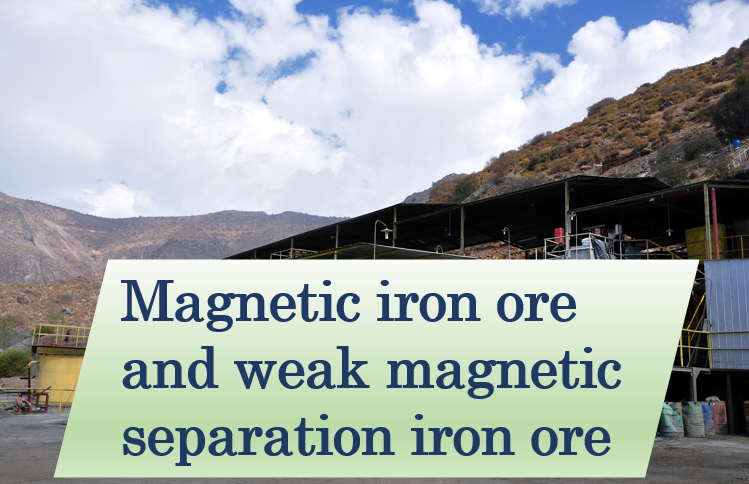The beneficiation methods of iron ore can be divided into several processes according to the type and properties of iron ore, including magnetic iron ore beneficiation, weak magnetic iron ore beneficiation, etc.
Magnetic iron ore is divided into single magnetic iron ore and multi-metal magnetic iron ore. The following editor will show you one by one.
Single magnetic ore
Single magnetic ore is mainly embedded in fine particles, and the gangue minerals are mainly silicate minerals such as quartz and amphibole, and some contain more iron silicates. For beneficiation of this type of iron ore, weak magnetic separation is usually used. In order to further obtain high-grade concentrate, the magnetic concentrate is then processed by reverse flotation or high-frequency screening
In water-scarce areas, dry grinding magnetic separation is used. When the rich magnetic ore or the poor magnetic ore is exhausted, the gangue minerals contained are first removed. For rich magnetic iron ore, it can be processed into block-shaped rich iron ore, and for poor iron ore, concentrate can be obtained after grinding.
In order to obtain high-grade concentrate, magnetite concentrate can be treated by reverse flotation or high-frequency screening. To improve the recovery rate, tailings reprocessing can be considered for further recovery.
Polymetallic and magnetic iron ore
Polymetallic magnetic iron ore is mainly sulfide magnetite, and there is a small amount of phosphate magnetite.
Magnetite is embedded in the ore with medium to fine particles, and the gangue has silicate or carbonate minerals, which are often associated with pyrite, cobalt pyrite or chalcopyrite, apatite, etc.
In the weak magnetic separation + flotation process, interlocking minerals mainly enter the iron concentrate; in the flotation + weak magnetic separation process, interlocking minerals mainly enter the sulfide concentrate.
Therefore, under the same grinding particle size, the flotation → weak magnetic separation process can obtain a sulfide concentrate with a lower sulfide content and a higher recovery rate.

Single weak magnetic iron ore
Single weak magnetic iron ore is composed of hematite, siderite, limonite and hematite in sedimentary metamorphic deposits, sedimentary, hydrothermal deposits and weathering deposits.
Due to the wide variety of minerals and different particle sizes, there are many methods for the beneficiation of single weak magnetic iron ore.
Commonly used methods include magnetization-calcination-magnetic separation or gravity separation, flotation, strong magnetic separation and other processes. Gravity separation, flotation and strong magnetic separation can also be used in combination.
Calcination magnetic separation
Calcination magnetic separation is one of the effective methods for selecting fine to fine particles (less than 0.02mm) of weakly magnetic iron ore.
When the ore contains rich minerals and is difficult to separate, the magnetization calcination magnetic separation method can be used first.
When the mineral composition in the ore is complex and it is difficult to obtain good indicators by other methods, the magnetization calcination magnetic separation method should be used.
For blocky ores of 20 to 75 mm, a vertical furnace can be used for reduction calcination.
Re-separation, flotation, strong magnetic separation or combined beneficiation process
Flotation is one of the common methods for separating weakly magnetic fine particles to tiny particles of iron ore.
Generally speaking, there are two common flotation processes: positive flotation and reverse flotation.
The former is suitable for quartz hematite without easily floating gangue, and the latter is suitable for quartz hematite with easily floating gangue.
For 2-20 mm weakly magnetic iron ore, gravity separation and strong magnetic separation are mainly used for beneficiation.
For weakly magnetic iron ore with a particle size greater than 20 mm, heavy medium separation and jigging separation are mainly used.
At present, due to the low recovery rate and output of gravity-selected fine iron ore, the strong magnetic-gravity separation combined process is mostly used.
The process first uses a strong magnetic separation process to separate a large amount of tailings, and then uses a gravity separation process to treat the strong magnetic concentrate to further improve the grade.
Multi-metal weakly magnetic iron ore
Multi-metal weakly magnetic iron ore is mainly hydrothermal type, sedimentary type phosphorus or sulfide-containing hematite or siderite.
This type of ore is often embedded in particles, closely coexisting with the gangue, with a magnesite structure, and difficult to dissociate.
Therefore, iron minerals in this type of ore are generally recovered by gravity separation, flotation, strong magnetic separation or combined processes, and phosphorus or sulfide is recovered by flotation.
If it is a rich ore or self-melting ore, heavy medium separation, jigging, or dry strong magnetic separation can be used to remove the gangue to obtain large pieces of iron ore.
If it is an olivine-rich ore, the calcination magnetic separation method can be used.
For poor olivine ores, even if calcination magnetic separation is used, the concentrate grade is difficult to reach more than 50%, so it can be mixed with other high-grade concentrates for further beneficiation.
Hydrothermal quartzite hematite and limonite often exist in an unevenly embedded manner, and are separated by gravity separation, strong magnetic separation, flotation and other combined processes.
© 2021 Yantai KZ Mining Processing Technology & Equipment Inc.